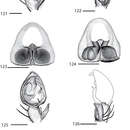Description
provided by Zookeys
Female holotype: Color:carapace light orange-brown to yellow-brown, duskier laterally, darker in fovea, some white setae present; sternum light yellowish-brown, darker around border; chelicerae brown, lighter anteromedially, and orange caudally; maxillae light brown, lightening distally; labium brown, lightening distally; abdomen dorsally with a grey-yellow background, 4 pair of spots anteriorly to medially, medial spots fused, light grey chevrons at second pair of spots and again after the 4th pair, which are fused, a single dot below that, laterocaudal festoon present, angled; ventrally cream-colored, dark laterally, caudally; legs orange-brown, annulations present, legs darkening distally, brown at metatarsus and tarsus. Carapace: 0.87 times longer than broad; fovea longitudinal, broad, very shallow. Eyes:AER slightly recurved; PER slightly recurved; PME larger than AME, PLE largest, ALE smallest; eye diameters, AME 0.18, ALE 0.08, PME 0.28, PLE 0.40; interdistances AME-PME 0.03, PME-ALE 0.10, ALE-PLE 0.38. PME-PME 1.20. ALE-ALE 1.98; ocular quadrangle AME-AME 0.40, PLE-PLE 2.09; clypeus 0.13 high. Mouthparts:chelicerae with a few stout setae medially and anteriorly; maxillae longer than broad, with tuft of conspicuous setae distally; labium distally rounded. Sternum:1.06 times longer than broad, posteriorly indented. Legs:leg I only slightly shorter than legs II, III and IV; leg formula 2431; scopulae present on all 4 tarsi and metatarsi and tibiae I and II; tarsi I-IV with strong claw tufts; pr claw per foot slightly toothed; spination: leg I, Fm pr 1–1–0, d 1–1–1, rl 1–1–1; Ti d 0, v 2–2–2; Mt v 2–2; leg II, Fm pr 1–0–0, d 1–1–1, rl 1–1–1; Ti v 2–2–2; Mt v 2–2; leg III, Fmpr 1–0–0, d 1–1–1, rl 1–0–1; Ti v 2–2–0; Mt v 2–1; leg IV, Fm pr 1–0–0, d 1–1–1, rl 0–0–1; Ti v 2–2–0; Mt v 2–1. Abdomen:without terminal setal tufts. Pedipalp:claw with 8 teeth. Epigyne:anteromedially, plate less sclerotized anteriorly compared to rest of plate, sinuous margin located anteriorly, genital openings located behind this, lateral lobes fused medially, epigynal pockets present; internally, ducts directed posteriorly, touching anteriorly, then separating medially, directed laterally, rounded terminally, fertilization ducts located and directed laterally, posterodorsal fold semi-circular, extending nearly half length of epigynal plate (Figs 129–130).Dimensions:Total length 9.15. Carapace length 3.48, width 4.00. Sternum length 1.85, width 1.75. Abdomen length 5.68, width 3.70. Pedipalp: Fm 1.00, Pt 0.25, Ti 0.75, Ta 1.45, total 3.45. Leg I: Fm 3.75, Pt 1.75, Ti 3.30, Mt 3.00, Ta 1.00, total 12.80. Leg II: Fm 4.75, Pt 1.50 Ti 4.00, Mt 3.00, Ta 1.50, total 14.75. Leg III: Fm 4.50, Pt 1.50, Ti 3.65, Mt 3.00, Ta 1.00, total 13.65. Leg IV: Fm 4.50, Pt 1.00, Ti 4.00, Mt 3.00, Ta 1.35, total 13.85.
- bibliographic citation
- Crews S (2011) A revision of the spider genus Selenops Latreille, 1819 (Arachnida, Araneae, Selenopidae) in North America, Central America and the Caribbean ZooKeys 105: 1–182
- author
- Sarah C. Crews
Distribution
provided by Zookeys
Endemic to the Dominican Republic and has a limited distribution on the southern Pedernales peninsula (Map 13).
- bibliographic citation
- Crews S (2011) A revision of the spider genus Selenops Latreille, 1819 (Arachnida, Araneae, Selenopidae) in North America, Central America and the Caribbean ZooKeys 105: 1–182
- author
- Sarah C. Crews

